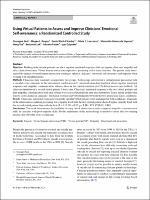Please use this identifier to cite or link to this item:
https://hdl.handle.net/20.500.12202/10157| Title: | Using virtual patients to assess and improve clinicians’ emotional self-awareness: A randomized controlled study |
| Authors: | Sarli, Giuseppe Rogers, Megan L. Bloch-Elkouby, Sarah Lawrence, Olivia Gomes de Siqueira, Alexandre Yao, Heng Lok, Benjamin Foster, Adriana Galynker, Igor 0000-0003-1555-3137 |
| Keywords: | Suicide Virtual human interaction (VHI) Virtual patient (VP) Empathy Emotional self-awareness |
| Issue Date: | 2024 |
| Publisher: | Springer International Publishing |
| Citation: | Sarli, G., Rogers, M., Bloch-Elkouby, S., Lawrence, O., Gomes De Siqueira, A., Yao, H., Lock, B., Foster, A., & Galynker, I. (2024). Using virtual patients to assess and improve clinicians’ emotional self-awareness: A randomized controlled study. Academic Psychiatry, 48(1), 18-28. https://doi.org/10.1007/s40596-023-01909-z |
| Series/Report no.: | Academic Psychiatry,;48(1) |
| Abstract: | •Objective: Working with suicidal patients can elicit negative emotional responses that can impede clinicians’ empathy and affect clinical outcomes. Virtual human interactions represent a promising tool to train clinicians. The present study investigated the impact of virtual human interaction training to enhance clinicians’ emotional self-awareness and empathy when working with suicidal patients. •Methods: Clinicians were randomly assigned into two groups. Both groups interviewed a virtual patient presenting with a suicidal crisis; clinicians in the intervention condition (n = 31) received immediate feedback about negative emotional responses and empathic communication, whereas those in the control condition (n = 33) did not receive any feedback. All clinicians interviewed a second virtual patient 1 week later. Clinicians’ emotional response to the two virtual patients and their empathic communication with each of them were assessed immediately after each interaction. Linear mixed models were used to assess change in clinicians’ emotional response and verbal empathy between the two interactions across conditions. •Results: Clinicians’ emotional responses toward the suicidal virtual patients were unchanged in both conditions. Clinicians in the intervention condition presenting low empathy level with the first virtual patient showed higher empathy level with the second virtual patient than with the first (B = 1.15, SE = 0.25, p < 0.001, 95% CI [0.42, 1.89]). •Conclusions: This work demonstrates the feasibility of using virtual human interactions to improve empathic communication skills in clinicians with poor empathy skills. Further refinement of this methodology is needed to create effective training modules for a broader array of clinicians. |
| Description: | Scholarly article |
| URI: | https://hdl.handle.net/20.500.12202/10157 |
| ISSN: | 1042-9670 1545-7230 |
| Appears in Collections: | Ferkauf Graduate School of Psychology: Faculty Publications |
Files in This Item:
| File | Description | Size | Format | |
|---|---|---|---|---|
| Bloch Elkoby 2023Dec6 OA UsingVirtualpatients AcadPsych.pdf | 782.75 kB | Adobe PDF |  View/Open |
This item is licensed under a Creative Commons License

